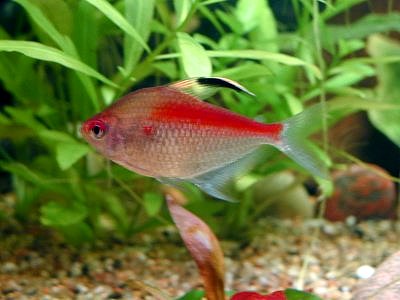Cherry spotted tetra or Perez tetra are certainly one of the most popular fish in community aquariums. Only in freshwater, of course. These fish have no place in brackish water. We will explain the detailed profile of the cherry spotted tetra and the keeping, breeding, origin and care in the following chapter. Let's always start with the origin of the fish.
 Hyphessobrycon erythrostigma (m), photographed by myself (Creative Commons) en:User:WIKIFAN-UL
Hyphessobrycon erythrostigma (m), photographed by myself (Creative Commons) en:User:WIKIFAN-UL
Origin and distribution of the cherry spotted tetra
Hyphessobrycon erythrostigma are fish, which mainly in the so-called blackwater life. These are mainly found in the upper Amazon basin. There you will find a variety of tetra species. For example, there is also the black phantom tetra, which due to its shape could be confused with the cherry spotted tetra. However, it is quite easy to distinguish between colors. Perhaps a word about the black water, because this will not mean something to everyone. Blackwater occurs primarily in tropical rivers. The name black water is no coincidence, because the main thing is that this water reflects the sunlight only a little and therefore looks rather black. The reason for this is the enrichment with many nutrients and suspended matter. The water has a brownish color which is due to dissolved humic acids and fulvic acids. This is mainly found in the Amazon Basin. There are blackwater rivers like the Congo in Africa or the Rio Negro in South America.
Characteristics and appearance of the cherry spotted tetra
Now we come to the appearance of the Cherry spotted tetra. In the large group of tetras, there are major differences in appearance. That's what the well-known see neon tetra completely different from, for example, the cherry spotted tetra. However, most tetras have one distinguishing feature. They have another small fin between the dorsal and the caudal fin. The cherry spotted tetra also has this. This fin is called adipose fin. The body of the tetra is scaled. But now we come to the characteristics of the cherry spotted tetra.
They can grow to around 6 cm. In exceptional cases, sizes up to 7 cm are also possible. But these are usually found in the wild. Due to this size, the fish should not be used in tanks with an edge length of less than 60 cm. It is better to keep an edge length of 80 cm as a minimum.
In aquaristics, in addition to the actual cherry spotted tetra, the Socolofs and red-backed cherry spotted tetra are also known.
The special distinguishing feature of the rather tall form of the cherry spotted tetra is its special coloring. They have a particularly distinctive red drawing in the form of a stripe on their back. This strip is also particularly easy to recognize and determine. The males are smaller than the females. In addition, males have a longer dorsal fin and anal fin.
Anyone who keeps cherry spotted tetras may find that they can change color over and over again. Or rather the color saturation. This is because they adapt depending on their well-being.
Keeping and caring for cherry spotted tetras
The lively swimmers can be kept very well in a freshwater community aquarium. They are extremely peaceful and require rather low currents in the aquarium. In addition, nothing special has to be considered in the area of planting.
A word about the requirements in terms of water parameters. Here you should make sure that the PH value is not over 7,5. The water should be rather acidic and cherry spotted tetras in a range of 6 can already be used. The temperature here is a good average between 22 and 28 degrees. The hardness of the water should also not exceed 12, since black water is usually rather soft water. This can be achieved by peat filtering. The softer and more acidic the water is, the more beautiful the color characteristics of the cherry spotted tetra come into their own.
We have already mentioned the size of the aquarium above. Do not use any cherry spotted tetras with an edge length of less than 80 cm. If you often read 60 cm in the profiles here.
When it comes to feeding, the cherry spotted tetra is less demanding and basically anything can be fed. Live food such as mosquito larvae is also popular. Basically, the posture can be classified as easy.
- Temperature 22-28 degrees
- PH value 6-7,5
- Hardness 12 maximum
- 80 cm edge length
- Lightly planted pool
- light current
- attitude simple
Breeding of the cherry spotted tetra
Of course we also want to take a closer look at the breeding of the fish. If you want to breed cherry spotted tetras, you have to face a number of challenges, because breeding them is not easy. Basically, it's about that here, too, as with the harlequin rasborato produce the right water. Values of hardness below 3 degrees and also a low PH value must be created here. This is without one osmosis system usually not possible. In addition, you can and should also enrich the water with humic acid. Peat filtering is used for this. The whole thing should take place in a breeding tank. You won't be able to do this in a community tank.
A couple is then used there. The fish then spawn accordingly. A particularly pronounced courtship behavior has already been observed in the males, although, as already mentioned, breeding offspring is rather unrealistic.
Good success is said to have already been achieved with the Socolofs cherry spotted tetra genus alone.



